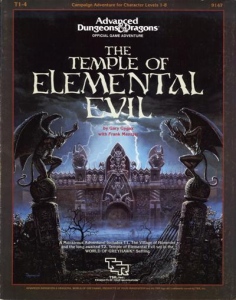Greyhawk, also known as the World of Greyhawk, is a fictional world designed as a campaign setting for the Dungeons & Dragons fantasy roleplaying game. Although not the first campaign world developed for Dungeons & Dragons—Dave Arneson's Blackmoor campaign predated it by about a year—the world of Greyhawk closely identified with early development of the game beginning in 1972, and after being published it remained associated with Dungeons & Dragons publications until 2008. The world itself started as a simple dungeon under a castle designed by Gary Gygax for the amusement of his children and friends, but it was rapidly expanded to include not only a complex multi-layered dungeon environment, but also the nearby city of Greyhawk, and eventually an entire world. In addition to the campaign world, which was published in several editions over twenty years, Greyhawk was also used as the setting for many adventures published in support of the game, as well as for RPGA's massively shared Living Greyhawk campaign from 2000–2008.

Tomb of Horrors is an adventure module written by Gary Gygax for the Dungeons & Dragons (D&D) role-playing game. It was originally written for and used at the 1975 Origins 1 convention. Gygax designed the adventure both to challenge the skill of expert players in his own campaign and to test players who boasted of having mighty player characters able to best any challenge. The module, coded S1, was the first in the S-series, or special series of modules. Several versions of the adventure have been published, the first in 1978, and the most recent, for the fifth edition of D&D, in 2017 as one of the included adventures in Tales from the Yawning Portal. The module also served as the basis for a novel published in 2002.
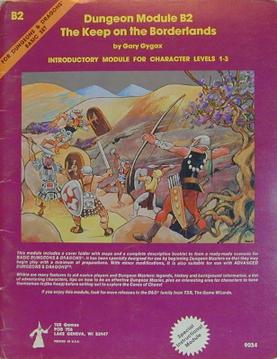
The Keep on the Borderlands is a Dungeons & Dragons adventure module by Gary Gygax, first printed in December 1979. In it, player characters are based at a keep and investigate a nearby series of caves that are filled with a variety of monsters. It was designed to be used with the Dungeons & Dragons Basic Set, and was included in the 1979–1982 editions of the Basic Set. It was designed for people new to Dungeons & Dragons.

Queen of the Demonweb Pits (Q1) is an adventure module for the Dungeons & Dragons roleplaying game written by David Sutherland. The "Q" in the module code is an abbreviation for "queen". The module, a sequel to the D series of modules, was novelized in 2001.
In the World of Greyhawk campaign setting for the Dungeons & Dragons roleplaying game, Tenser is an archmage who strives to rid the Flanaess of evil. Tenser is a former member of both the Citadel of Eight and the Circle of Eight.

Descent Into the Depths of the Earth is an adventure module for the Dungeons & Dragons (D&D) fantasy roleplaying game coded D1–2. It was written by Gary Gygax, and combines two previously published modules from 1978, the original Descent into the Depths of the Earth and Shrine of the Kuo-Toa. A sequel to the first two modules, Vault of the Drow, was also published in 1978. All of these D-series modules were produced for use with the 1st edition Advanced Dungeons & Dragons (AD&D) rules.
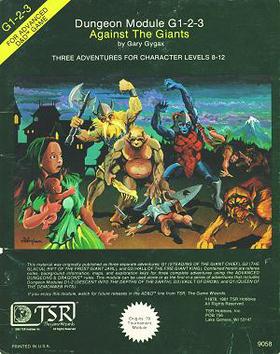
Against the Giants is an adventure module written by Gary Gygax and published by TSR in 1981 for the Dungeons & Dragons fantasy role-playing game. It combines the G series of modules previously published in 1978: Steading of the Hill Giant Chief, Glacial Rift of the Frost Giant Jarl, and Hall of the Fire Giant King. All three were produced for use with the 1st edition Advanced Dungeons & Dragons rules. In 1999, to recognize the 25th anniversary of TSR, the company released an updated version, Against the Giants: The Liberation of Geoff. Later in 1999, Wizards of the Coast published a novelization of Against the Giants by Ru Emerson.
In the Dungeons & Dragons fantasy roleplaying game, Tharizdun is the god of Eternal Darkness, Decay, Entropy, Malign Knowledge, Insanity, and Cold. He originated in the World of Greyhawk campaign setting but has since also appeared in other settings.

The Forgotten Temple of Tharizdun is an adventure module for the Dungeons & Dragons (D&D) role-playing game, for use in the World of Greyhawk campaign setting. The module was published by TSR, Inc. in 1982 for the first edition Advanced Dungeons & Dragons rules.

Iggwilv is a fictional wizard from the Greyhawk campaign setting for the Dungeons & Dragons roleplaying game. She was created by Gary Gygax.
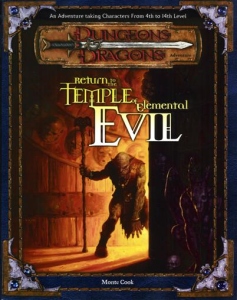
Return to the Temple of Elemental Evil is an adventure module written by Monte Cook for the 3rd edition of the Dungeons & Dragons fantasy roleplaying game, set in the game's World of Greyhawk campaign setting. It was originally published by American game company Wizards of the Coast in 2001 as a sequel to the 1985 Advanced Dungeons & Dragons (AD&D) module, The Temple of Elemental Evil.

Jacob Franklin Mentzer III is an American fantasy author and game designer who worked on early materials for the Dungeons & Dragons (D&D) fantasy role-playing game. He was an employee of TSR, Inc. from 1980 to 1986, spending part of that time as creative advisor to the chairman of the board, Gary Gygax. He also founded the Role-Playing Games Association (RPGA) during his time with TSR.
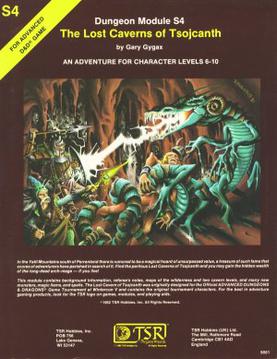
The Lost Caverns of Tsojcanth is an adventure module for the Dungeons & Dragons fantasy role-playing game. It was written by Gary Gygax and published by TSR in 1982 for the first edition Advanced Dungeons & Dragons (AD&D) rules. The 64-page adventure bears the code "S4" and is set in the Greyhawk campaign setting. It is divided into two parts, a 32-page adventure, and a 32-page booklet of monsters and magic items. The plot involves the player characters investigating rumors of lost treasure. After traversing a wilderness and two levels of dungeons, the players face Drelnza, the vampiric daughter of long-deceased archmage Iggwilv.
Tritons are a fictional species in the Dungeons & Dragons fantasy role-playing game.
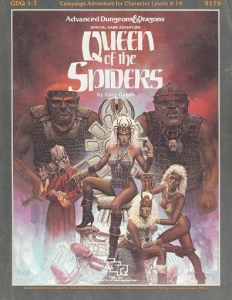
Queen of the Spiders is an adventure module for the Dungeons & Dragons fantasy role-playing game. It was published by TSR, Inc. in 1986 and is a compilation of seven previous related modules, often referred to as a "supermodule." Together, the seven adventures form an integrated campaign that begins in the World of Greyhawk, continues underground into the Underdark, and concludes in the Demonweb Pits, the abyssal lair of the demonic goddess Lolth. The campaign was originally intended for use with the rules from the first edition of Advanced Dungeons & Dragons.
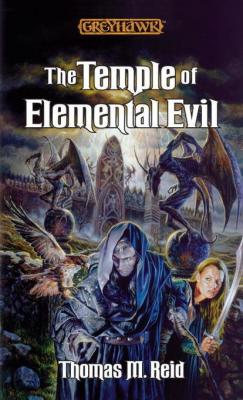
The Temple of Elemental Evil is a 2001 fantasy novel by Thomas M. Reid. It is set in the world of Greyhawk and based on the Dungeons & Dragons role-playing game, specifically the adventure T1-4 The Temple of Elemental Evil.

The Expert Set is an expansion boxed set for the Dungeons & Dragons fantasy role-playing game. It was first published in 1981 as an expansion to the Basic Set.
This is a bibliography of American game designer and author Gary Gygax.
